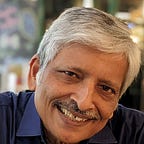“Life as a Reflection, Life as a Dream”
An Introduction to the Films in the Andrei Tarkovsky Retrospective at the Bengaluru International Film Festival BIFFES 2020
The legendary Russian auteur Andrei Tarkovsky’s cinema may appear elusive even to those who have some exposure to world cinema. The following tribute to Tarkovsky by another master filmmaker, Ingmar Bergman, helps to understand what Tarkovsky attempted and points to Tarkovsky’s pre-eminence: “My discovery of Tarkovsky’s first film was like a miracle. Suddenly, I found myself standing at the door of a room the keys of which had until then, never been given to me. It was a room I had always wanted to enter and where he was moving freely and fully at ease. I felt encountered and stimulated: someone was expressing what I had always wanted to say without knowing how. Tarkovsky is for me the greatest, the one who invented a new language, true to the nature of film, as it captures life as a reflection, life as a dream.” Following is a brief introduction to the films in the retrospective.
Ivan’s Childhood (1962), Tarkovsky’s first feature film, based on the short story “Ivan” by Vladimir Bogomolov, shows his distinct cinematic style. Revolving around a young orphan, driven to take revenge on the Germans during the war, the story is not told in a linear plot. Tarkovsky punctuates the narrative with dreams. The film is full of evocative images such as apples falling from a truck on a beach and horses nibbling on them, Ivan looking for a star at the bottom of a well etc. Such images may be puzzling but, in his book, “Sculpting in Time” Tarkovsky has written that each art-form has its unique formative element such as “word” for novel, “character” for drama and “color” for painting. Tarkovsky argues that for cinema the formative element is “time” and a finished film for him is a collection of passages of time.
Andrei Rublev (1966), Tarkovsky’s second film, was about the fifteenth century icon painter who witnessed major upheavals such as the gory raids of the Tatars. The film captures the period in which Rublev lived in eight episodes that are loosely put together. Andrei Rublev has memorable images of a man flying on a hot air balloon over waterways, running horses, pouring rain etc. The film features a re-enactment of Christ’s crucifixion. The epilogue breaks into color and shows details of Andrei Rublev’s icons.
Solaris (1972) was based on the science fiction novel by the same name by Stanislaw Lem. The film achieves the challenging task of depicting human consciousness using cinematic expression. It has one of the finest moments of cinema featuring levitation which is a recurring imagery in some of his other films. Tarkovsky was inspired by a similar imagery in his father Arseny Tarkovsky’s poem. There is a hypnotic highway scene that creates a contemplative mood. Tarkovsky alternates between color and monochrome to neutralize the effect of color as it ruins the expressiveness of the image.
The Mirror (1975) is a partly autobiographical film about the memories and reflexions of a middle-aged man. It has not been put together in a chronological order. The audience has to figure out the pre-war, war and post war sequences and make meaning. This has some of the stunning images of levitation and burning house that recur in Tarkovsky’s other films. The same actress plays the protagonist’s mother as well as his wife. This is to depict the effect his mother had even on his relationship with his estranged wife.
Stalker (1979) was based on the script written by the Strugatsky brothers based on their novel titled “Roadside Picnic” although the script was considerably changed by Tarkovsky. A scientist and a writer are taken by an illegal guide, Stalker, through a mysterious and forbidden territory called “Zone” to reach “The Room” that fulfils wishes of those who enter it. This film makes extraordinary use of sound and electronic music, particularly in the haunting train scene.
Nostalghia (1983) is about a Russian writer on a visit to Italy to research on an 18th century Russian composer. The acute feeling of nostalgia the writer experiences is caused not just by his separation from his native land but also by a yearning for a harmony that the world sorely lacks. This is a film that reflects what Tarkovsky went through as he decided to live in the west as well as his views on the wholeness of existence.
The Sacrifice (1986), Tarkovsky’s swan song, is set in the aftermath of a nuclear missile attack that spells doom on the earth. A man is willing to sacrifice even his most prized possession in return for restoring the world to its normal state. The penultimate scene is a 10-minute virtuoso long take. After an optimistic note, the film is dedicated to Tarkovsky’s son Andriosha “with hope and confidence”.
